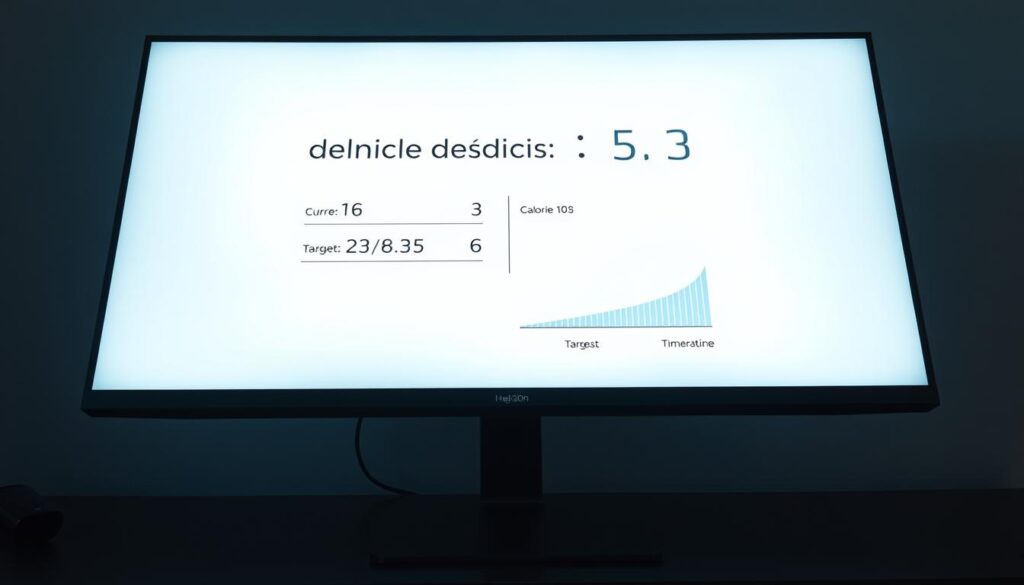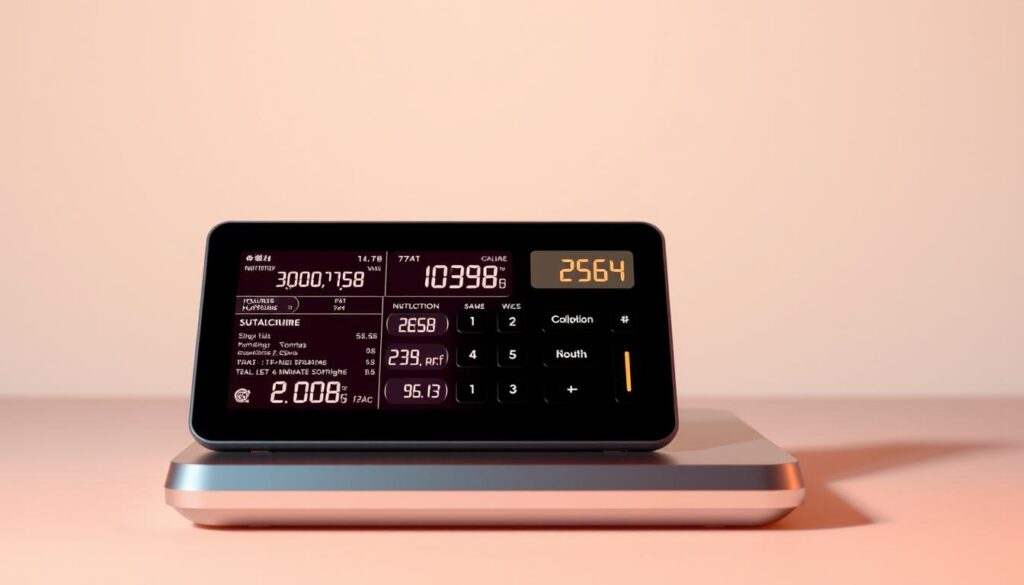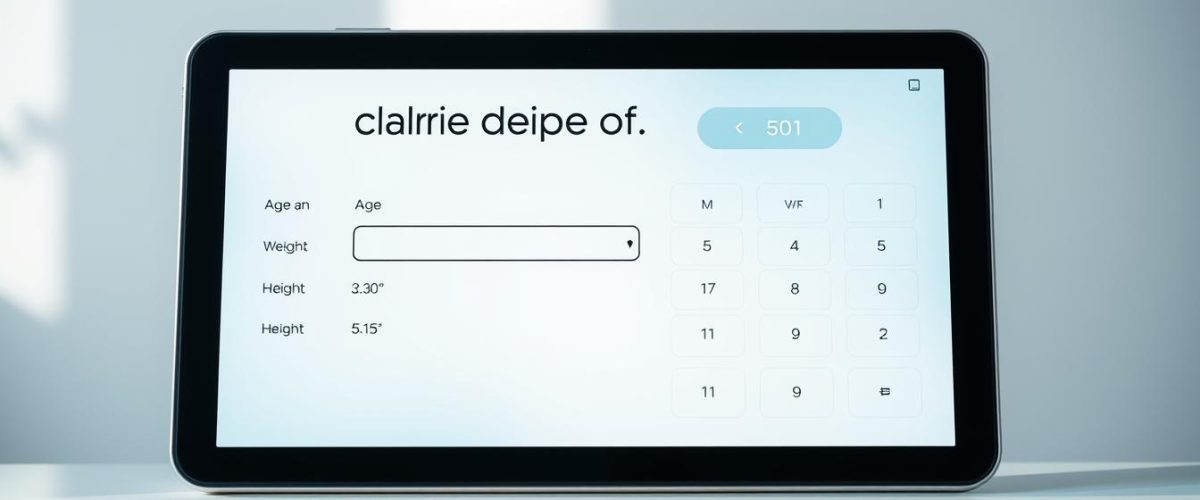Are you having trouble losing weight even with a strict diet and exercise? The secret to losing weight is knowing your daily calorie needs. You need to create a calorie deficit to burn fat.
A calorie deficit calculator is a handy tool. It helps you figure out how many calories you should eat to lose weight. It considers your age, how active you are, and your weight loss goals.
With a calorie deficit calculator, you can make a plan that fits you. This makes it easier to reach your weight loss goals.
What is a Calorie Deficit?
A calorie deficit happens when you burn more calories than you eat. This is key for losing weight. To do this, you must know how your body uses calories.
Understanding Caloric Intake and Expenditure
Caloric intake is the calories you get from food and drinks. Caloric expenditure is the calories your body burns for energy. Your daily calorie burn includes your basal metabolic rate (BMR), activity, and food digestion.
To simplify, let’s break down your daily caloric expenditure into components:
| Component | Description | Example Percentage |
|---|---|---|
| Basal Metabolic Rate (BMR) | Energy expended at rest | 60% |
| Physical Activity | Energy expended during exercise and daily activities | 30% |
| Thermic Effect of Food | Energy expended in digesting food | 10% |
Importance of Calorie Deficit for Weight Loss
Creating a calorie deficit is key for weight loss. It tells your body to use fat for energy. The bigger the deficit, the more weight you lose. But, it’s important to keep it balanced to stay healthy.
To calculate your calorie deficit, use a calorie deficit calculator. It considers your BMR, activity level, and weight loss goals. Knowing how to calculate your calorie deficit is crucial for effective weight loss.
How to Use a Calorie Deficit Calculator
To reach your weight loss goals, knowing how to use a calorie deficit calculator is key. This tool figures out the right amount of calories you should eat to lose weight. It does this by finding the difference between how many calories you burn and how many you eat.
Step-by-Step Guide to Inputting Data
Using an online calorie deficit calculator is easy. Here’s how to put in your information:
- Enter your age, gender, weight, and height.
- Provide your activity level, which can range from sedentary to highly active.
- Input your weight loss goal, whether it’s to lose weight gradually or more aggressively.
- Some calculators may ask for additional information, such as body fat percentage or specific dietary preferences.
By accurately inputting this data, you can get a more precise calculation of your calorie deficit.
Interpreting Your Results
After you’ve put in your data into a best calorie deficit calculator, you’ll see a result. This result shows how many calories you should eat to lose weight.
For example, if you need 2,500 calories a day to maintain your weight and you want to lose weight, your calculator might suggest eating 2,000 calories a day. This creates a calorie deficit. Remember, losing 1-2 pounds a week is a safe and healthy pace.
Always talk to a healthcare professional or a registered dietitian before changing your diet or exercise routine a lot.
Benefits of Tracking Your Caloric Intake
Tracking your caloric intake can greatly help with weight management. It lets you make smart choices about what you eat and how much you exercise. This leads to a healthier life.
Enhanced Weight Management
One big plus of tracking calories is enhanced weight management. A free calorie deficit calculator or an accurate calorie deficit calculator helps figure out how many calories you need. This keeps you on track with your weight loss goals and prevents eating too much or too little.
- Monitor your progress and adjust your diet accordingly
- Set realistic weight loss goals based on your caloric intake
- Avoid overeating or under-eating by tracking your daily caloric intake
Improved Dietary Choices
Tracking calories also means improved dietary choices. Knowing your daily caloric needs helps you choose healthier foods. A calorie deficit calculator shows you foods that are nutritious but low in calories.
“The key to successful weight loss is not just about cutting calories, but making sustainable lifestyle changes that promote overall health and wellbeing.”
Using a calorie deficit calculator helps you make better diet and exercise choices. This leads to sustainable weight loss and better health.
Calculating Your Basal Metabolic Rate (BMR)
Knowing your Basal Metabolic Rate (BMR) is key to figuring out how many calories you need every day. Your BMR is the number of calories your body burns when you’re resting. It’s a basic part of figuring out how many calories you need for weight loss or keeping your weight the same.
Factors Affecting BMR
Many things can change your BMR, like your age, sex, weight, and height. Men usually have a higher BMR than women because they have more muscle. As you get older, your BMR goes down because you lose muscle. Your weight and height also matter because a bigger body needs more energy to work.
Key factors that affect BMR include:
- Age: BMR decreases with age.
- Sex: Men typically have a higher BMR than women.
- Weight: More body mass requires more energy.
- Height: Taller individuals generally have a higher BMR.
- Body composition: Muscle mass vs. fat mass.
Tools to Calculate Your BMR
There are many ways to find out your BMR, from online calculators to advanced tests. Using a calorie deficit calculator for weight loss can also help you see how your BMR affects your weight loss.
Some popular ways include:
- Online BMR calculators that use the Harris-Benedict equation or Mifflin-St Jeor equation.
- Metabolic carts or calorimeters for more precise measurements.
- Mobile apps that track your caloric intake and expenditure.
By knowing your BMR and using the right tools, you can make smart choices about your diet and exercise. This helps you reach your weight loss goals more effectively.
Determining Your Daily Caloric Needs
To reach your weight loss goals, knowing your daily caloric needs is key. This means figuring out how many calories your body needs at rest and during activity. Then, adjust that number to fit your weight loss goals.
Active vs. Sedentary Lifestyles
Your activity level greatly affects your daily caloric needs. If you’re sedentary, you need fewer calories than someone who is active. For example, athletes or those with demanding jobs need more calories to stay at their weight or lose weight.
Here’s a table showing estimated daily caloric needs for adults based on activity level:
| Activity Level | Male, 30 years, 154 lbs, 5’9″ | Female, 30 years, 126 lbs, 5’4″ |
|---|---|---|
| Sedentary | 2,400 calories | 1,800 calories |
| Lightly Active | 2,800 calories | 2,000 calories |
| Moderately Active | 3,000 calories | 2,200 calories |
| Very Active | 3,200 calories | 2,400 calories |
| Extra Active | 3,600 calories | 2,800 calories |
Adjusting for Weight Loss Goals
To lose weight, you need to eat fewer calories than you burn. A safe weight loss is 1-2 pounds a week. This usually means eating 500-1000 calories less each day.
A daily calorie deficit calculator can help. Just enter your details like weight, activity level, and weight loss goals. It will tell you how many calories you should eat each day.
A registered dietitian says, “Creating a calorie deficit is not just about cutting calories. It’s about giving your body the right fuel for function while losing weight.”
“A calorie deficit is achieved when you consume fewer calories than your body burns. It’s a simple yet effective principle for weight loss.”
By understanding and applying these principles, you can find your daily caloric needs. This will help you move closer to your weight loss goals.
Examples of Calorie Deficit Calculations
Calculating your calorie deficit is easy and can help you lose weight. By using a calorie deficit calculator, you can adjust your diet to meet your weight loss goals.
Real-Life Scenarios
Let’s look at some examples of how calorie deficit calculations work. For instance, a 30-year-old woman who weighs 150 pounds and is moderately active needs 1,800 calories a day to stay the same weight. To lose weight, she could eat 1,500 calories a day, creating a 300-calorie deficit.
A 40-year-old man who is sedentary and weighs 200 pounds might need 2,500 calories a day to maintain his weight. If he eats 2,000 calories and burns 250 more calories through exercise, he has a 750-calorie deficit each day.

Common Mistakes to Avoid
When figuring out your calorie deficit, it’s easy to make mistakes. One common error is underestimating how many calories you eat. To avoid this, keep a food diary to track what you eat.
Another mistake is not adjusting your calorie deficit as you lose weight. As you get lighter, your maintenance calories will change. You’ll need to recalculate your calorie deficit. Using a calorie deficit calculator regularly can help you stay on track.
Lastly, don’t cut calories too much. This can lead to not getting enough nutrients and a slower metabolism. A safe and sustainable rate of weight loss is 1-2 pounds per week.
By understanding how to calculate calorie deficit and avoiding common mistakes, you can use calorie deficit to reach your weight loss goals.
Setting Realistic Weight Loss Goals
Setting realistic weight loss goals is key to a successful weight management plan. Achievable targets keep you motivated and help you track your progress. A best calorie deficit calculator or an online calorie deficit calculator can guide you to a calorie deficit that fits your goals.
Short-Term vs. Long-Term Goals
It’s important to have both short-term and long-term weight loss goals. Short-term goals give you immediate motivation. Long-term goals help your weight loss last over time. For example, a short-term goal might be to lose 5 pounds in a month. A long-term goal could be to lose 20 pounds in 6 months.
To reach these goals, planning your calorie deficit is crucial. An online calorie deficit calculator can help you figure out how many calories to cut from your diet.
The Role of Sustainable Practices
For lasting weight loss, sustainable practices are essential. This means adopting healthy eating habits and regular exercise. Crash diets and extreme calorie cuts can harm your health and lead to weight gain.
- Focus on gradual weight loss
- Incorporate a balanced diet rich in fruits, vegetables, and whole grains
- Stay hydrated and limit processed foods
- Engage in regular physical activity that you enjoy
Using a best calorie deficit calculator helps you find a calorie deficit that works for you. This method not only aids in weight loss but also helps you keep the weight off. It ensures a healthier, more sustainable you.
Tips for Maintaining a Calorie Deficit
To keep a calorie deficit, focus on eating nutrient-dense foods and planning your meals well. This means making smart choices about what and when you eat. It helps fuel your body while keeping calories low.
Healthy Snacking Ideas
Snacking can be hard when you’re trying to lose weight. But, picking the right snacks can help control hunger and aid in weight loss. Try adding healthy fats like nuts, seeds, and avocados to your snacks.
- Raw almonds
- Carrot sticks with hummus
- Protein-rich Greek yogurt
A nutrition expert says, “Healthy snacking is about making smart choices that satisfy hunger and give essential nutrients.”
“The key to successful snacking is to focus on whole, unprocessed foods that are rich in nutrients and low in added sugars, salt, and unhealthy fats.”
Meal Planning and Prep Strategies
Good meal planning is key for a calorie deficit. Preparing meals ahead ensures you get the right nutrients and stay within calorie limits. Use a free calorie deficit calculator to figure out your daily calorie needs and plan your meals.
| Meal | Calories | Protein |
|---|---|---|
| Breakfast | 300 | 25g |
| Lunch | 400 | 35g |
| Dinner | 500 | 40g |
With a calorie deficit calculator formula, you can set your daily calorie deficit and plan meals for weight loss. For instance, if you need 2,000 calories a day, a 500-calorie deficit means eating 1,500 calories daily.
By mixing healthy snacks with good meal planning, you can keep a calorie deficit and reach your weight loss goals. Don’t forget to drink plenty of water and listen to your body’s nutritional needs.
The Role of Exercise in a Calorie Deficit
To lose weight effectively, knowing how exercise fits into a calorie deficit is key. Exercise not only burns calories but also builds muscle. This can boost your metabolism.

Types of Exercise for Weight Loss
Several exercises can help with weight loss when you’re in a calorie deficit. These include:
- Cardio Exercises: Running, cycling, and swimming are great for burning calories.
- Strength Training: Lifting weights or doing bodyweight exercises helps build muscle.
- High-Intensity Interval Training (HIIT): This involves short bursts of intense exercise followed by brief periods of rest.
Balancing Cardio and Strength Training
A good exercise routine should mix cardio and strength training. Cardio exercises burn calories during the activity. Strength training increases your resting metabolic rate.
To find a balance:
- Begin with 2-3 days of cardio each week, choosing activities you like.
- Add strength training 2-3 times a week, focusing on major muscle groups.
- Change your routine as needed based on your progress and body response.
Using an accurate calorie deficit calculator helps figure out how much exercise you need. A daily calorie deficit calculator guides your daily caloric intake and expenditure.
Tracking Your Progress
Keeping an eye on your progress is crucial for losing weight. It helps you stay focused and make changes when needed. By tracking regularly, you can spot trends, celebrate wins, and see what needs work.
Tools and Apps to Monitor Your Journey
Today, many tools and apps help you track your weight loss. Apps like MyFitnessPal and fitness trackers like Fitbit give you insights into your calories. They show how much you eat and burn each day.
Some top choices include:
- MyFitnessPal for tracking calories
- Fitbit for monitoring daily activity
- Apple Health for integrating various health metrics
Importance of Consistency and Adaptation
Being consistent is key to tracking your progress. Regular checks help you adjust your plan to reach your goals. It’s also crucial to be open to changing your approach based on your data.
Here’s a look at how different tracking methods compare:
| Tracking Method | Benefits | Limitations |
|---|---|---|
| Mobile Apps | Easy to use, comprehensive databases | May require premium subscription for full features |
| Wearable Devices | Continuous monitoring, user-friendly | Battery life can be a limitation |
| Manual Logging | No dependency on technology, cost-effective | Time-consuming, prone to human error |
Using a calorie deficit calculator for weight loss can help a lot. It sets a clear goal for your diet and exercise. Knowing how to calculate calorie deficit is key to making smart choices.
When to Consult a Professional
Weight loss can be tough, and knowing when to get help is key. A best calorie deficit calculator is a good start. But, your health, diet, and what you like also matter a lot.
Recognizing When You Need Help
If you’re not losing weight with an accurate calorie deficit calculator, it’s time to get help. Look out for these signs:
- Plateaus in weight loss
- Difficulty maintaining dietary changes
- Presence of health conditions that complicate weight loss
- Uncertainty about how to adjust your calorie deficit
A healthcare pro can help you figure out what’s holding you back. They’ll create a plan just for you.
Finding the Right Nutritionist or Dietitian
Finding the right expert is crucial. Here’s how to do it:
- Check for relevant certifications (e.g., RD, RDN)
- Review their experience with clients like you
- Schedule a consultation to see if you click
| Professional Credential | Description |
|---|---|
| RD (Registered Dietitian) | A healthcare pro with nutrition and dietetics know-how |
| RDN (Registered Dietitian Nutritionist) | Like RD, but with a focus on both dietetics and nutrition |
Using a best calorie deficit calculator with expert advice can really help. It makes a plan that fits your calorie needs and more for lasting weight loss.
By mixing expert advice with an accurate calorie deficit calculator, you get a solid weight loss plan. It’s both effective and lasting.
Common Myths About Calorie Deficits
When using a calorie deficit calculator, it’s key to know what’s real and what’s not. Many myths surround calorie deficits, causing confusion and wrong information.
Debunking Misconceptions
One myth is that a calorie deficit means starving yourself. But, a daily calorie deficit calculator helps you lose weight safely. It balances what you eat with how much you burn.
You can use a calorie deficit calculator to figure out your daily calorie needs. Then, adjust your diet to meet those needs.
Understanding Eating Disorders Risks
While a calorie deficit calculator is helpful, use it wisely. Know the dangers of eating disorders like anorexia and bulimia. These can happen if you cut calories too much.
If you’re worried about eating disorders or body image, talk to a doctor or dietitian. They can help you stay healthy while losing weight.
By knowing the truth about calorie deficits and using calculators right, you can reach your weight loss goals. And keep a good relationship with food.


